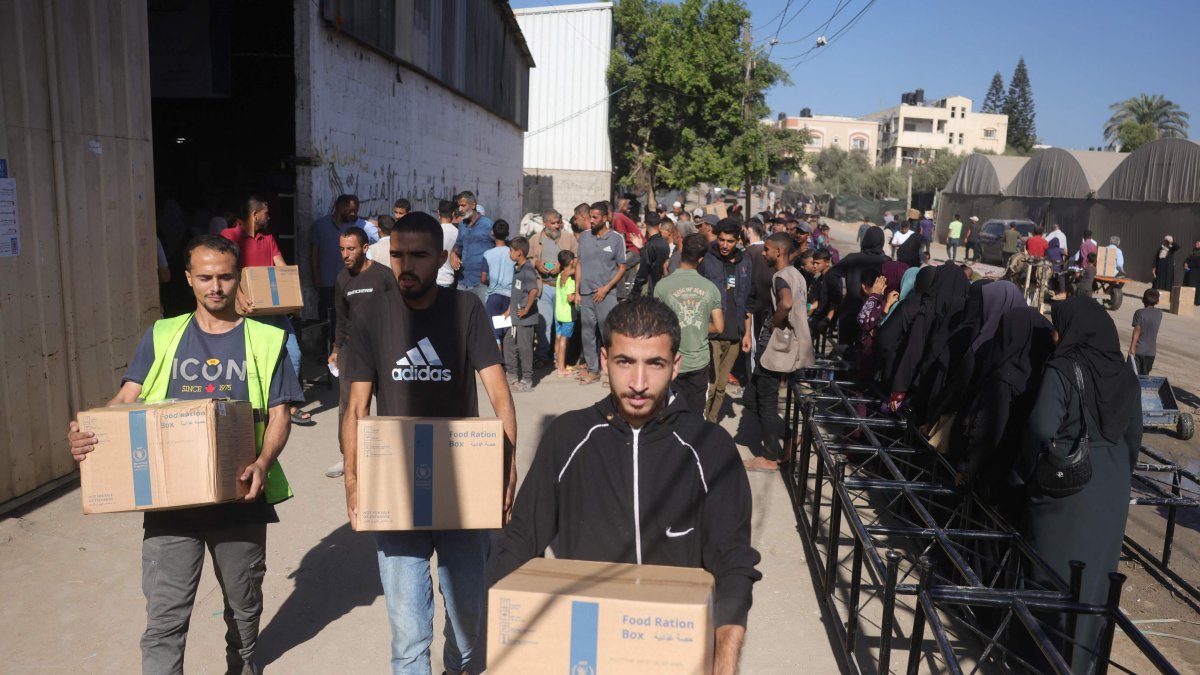Israel continues to restrict humanitarian aid to Gaza nearly a month after a cease-fire that was supposed to allow 600 aid trucks per day, humanitarian groups warned Tuesday, as hunger persists, fuel shortages worsen and winter approaches in the war-ravaged enclave.
The truce was meant to unleash a surge of humanitarian assistance across the devastated territory, where famine was confirmed in August and nearly all 2.3 million residents have lost their homes in Israel’s two-year-long attacks.
However, only half the required amount of food is entering Gaza, according to the World Food Programme (WFP), while a coalition of Palestinian aid agencies said total deliveries are only between one-quarter and one-third of what was pledged.
Israel insists it is meeting its obligations under the cease-fire, which calls for 600 truckloads of supplies into Gaza each day. It blames Hamas for food shortages, accusing the group of stealing aid before distribution – claims Hamas denies.
Gaza’s local administration says the reality is starkly different: most trucks are still blocked or delayed under Israeli restrictions, and only about 145 per day are delivering supplies.
The United Nations, which once published daily figures for aid entering Gaza, has stopped releasing them routinely – a decision aid groups say obscures the true scale of the crisis.
‘Tents completely worn out’
“It is dire. No proper tents, or proper water, or proper food, or proper money,” said Manal Salem, 52, who lives in a tent in Khan Younis in southern Gaza that she says is “completely worn out” and unlikely to withstand the winter.
The cease-fire and limited flow of aid since mid-October have brought some relief, according to the U.N. humanitarian office, OCHA. Last week, OCHA reported that 10% of children screened in Gaza were acutely malnourished, down from 14% in September, with more than 1,000 suffering the most severe form of malnutrition.
Half of families in Gaza have reported better access to food, particularly in the south, as aid and commercial goods trickled in after the truce. Households now average two meals a day, up from one in July, OCHA said. But conditions remain catastrophic in the north, where access is still tightly restricted.
‘A race against time’
Abeer Etefa, a senior WFP spokesperson, described the situation as a “race against time.”
“We need full access. We need everything to be moving fast,” she said. “The winter months are coming. People are still suffering from hunger, and the needs are overwhelming.”
Since the cease-fire, the agency has brought in 20,000 metric tons of food assistance – roughly half the amount needed to meet basic nutritional needs – and opened 44 of a planned 145 distribution sites.
The variety of food required to prevent malnutrition is also missing, Etefa added.
“The majority of households that we’ve spoken to are only consuming cereals, pulses and dry food rations, which people cannot survive on for long,” she said. “Meat, eggs, vegetables, fruits — these are consumed extremely rarely.”
Fuel, shelter and health risks
A continuing lack of fuel, including cooking gas, is worsening the crisis. OCHA says over 60% of Gazans are burning waste to cook, heightening health risks.
As temperatures drop, inadequate shelter is compounding the suffering. Many tents are fraying or collapsing, and buildings that survived Israeli bombardment are often unstable or exposed to the elements.
“We’re coming into winter soon – rainwater and possible floods, as well as potential diseases because of the hundreds of tons of garbage near populated areas,” said Amjad al-Shawa, head of the Palestinian NGO network that coordinates with the U.N.
He said only 25 to 30% of the aid expected into Gaza has entered so far.
“The living conditions are unimaginable,” said Shaina Low, a spokesperson for the Norwegian Refugee Council, which leads efforts to address Gaza’s shelter crisis.
The NRC estimates that 1.5 million people need shelter, yet large volumes of tents, tarpaulins and other supplies remain stuck at the border awaiting Israeli approval, Low said.
Despite modest gains in parts of southern Gaza, aid workers emphasize the vast inequality in access across the strip. The north, still under severe restriction, continues to face famine-like conditions, while displaced families in the south struggle with overcrowding and cold.
Humanitarian officials warn that without full access and consistent deliveries of fuel, food and shelter materials, Gaza’s humanitarian collapse will deepen.
“Every day of delay means more children go hungry, more people sleep in the cold, and more lives are at risk,” Etefa said.

The Daily Sabah Newsletter
Keep up to date with what’s happening in Turkey,
it’s region and the world.
SIGN ME UP
You can unsubscribe at any time. By signing up you are agreeing to our Terms of Use and Privacy Policy.
This site is protected by reCAPTCHA and the Google Privacy Policy and Terms of Service apply.

